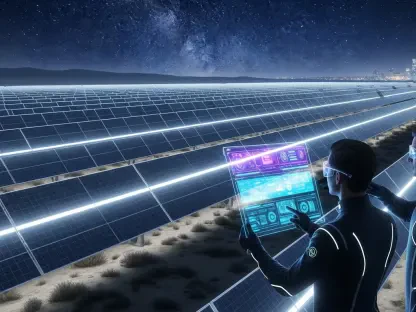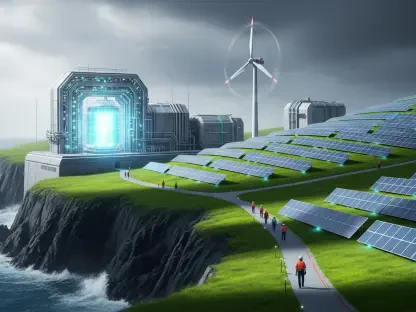Imagine a world where Earth’s climate, often thought to be a self-regulating system much like a finely tuned thermostat, suddenly malfunctions in a way that transforms scorching global warming into a deep freeze reminiscent of an ice age, a scenario not from a science fiction novel but the focus of a groundbreaking study. Conducted by the University of California, Riverside, and recently published in Science, this research titled “Instability in the Geological Regulation of Earth’s Climate” unveils a startling reality: the planet’s natural mechanisms for maintaining temperature balance can sometimes spiral into dramatic and unexpected swings. Far from being a mere historical curiosity, these findings resonate with today’s pressing climate challenges, urging a reevaluation of how climate stability is understood.
The study shatters the traditional view that geological processes, such as silicate weathering—where rocks absorb carbon dioxide (CO2) from the atmosphere to cool the planet—act as the sole guardians of Earth’s climate over long timescales. Instead, it highlights the powerful and often overlooked role of biological feedbacks, particularly the burial of organic carbon by marine organisms. Under specific conditions, these biological processes can dominate, pushing the planet from extreme heat into prolonged cold spells that rival past glacial periods. This revelation, backed by advanced simulations, paints Earth’s climate system as far more volatile than previously assumed, with implications that span from ancient history to modern environmental concerns.
Unpacking Earth’s Climate Feedbacks
The Traditional View: Silicate Weathering as the Stabilizer
For centuries, the scientific community has regarded silicate weathering as the cornerstone of Earth’s long-term climate regulation, a process where rising temperatures accelerate the breakdown of rocks, which in turn absorb CO2 from the atmosphere and cool the planet. This mechanism has been seen as a reliable stabilizer, operating over millions of years to maintain a delicate balance. It functions on the principle that warmer conditions speed up chemical reactions in rocks, drawing down greenhouse gases in a predictable cycle. The assumption has long been that this geological feedback would always bring temperatures back to equilibrium, no matter the initial disturbance, acting as a safeguard against runaway climate shifts.
However, this perspective is not without flaws, especially when confronted with extreme climate events. The recent research suggests that silicate weathering, while effective under normal circumstances, can be outpaced during massive warming episodes triggered by events like volcanic eruptions or rapid carbon releases. When the system is pushed beyond its typical limits, the slow pace of geological regulation struggles to keep up, leaving room for other, faster-acting mechanisms to take over. This gap in responsiveness reveals a critical vulnerability in what was once thought to be an unshakable foundation of climate stability, prompting scientists to reconsider the full spectrum of forces at play in Earth’s temperature regulation.
A New Player: Biological Feedbacks
Stepping into this breach is a lesser-known but remarkably potent force: the burial of organic carbon by marine organisms, a biological feedback that can dramatically alter Earth’s climate trajectory. During periods of intense warming, nutrient-rich runoff from weathered land pours into oceans, fueling the growth of microscopic marine life. In oxygen-poor environments, the remains of these organisms sink and are buried, effectively sequestering large amounts of CO2 from the atmosphere at a startling rate. Unlike the gradual pace of silicate weathering, this process can trigger rapid cooling, sometimes overshooting the initial warming to plunge the planet into a frigid state that persists for over 100,000 years.
What makes this feedback so significant is its potential to overshadow traditional geological regulators under certain conditions, acting as an unpredictable switch in Earth’s climate system. The simulations conducted in the study demonstrate that this biological mechanism doesn’t merely correct a temperature spike—it can overcorrect, driving global temperatures far below their starting point. This capacity for extreme shifts highlights a previously underappreciated dynamism in how the planet responds to carbon imbalances. It suggests that life in the oceans, often seen as a passive component of the climate puzzle, holds a commanding influence capable of rewriting the rules of planetary cooling and warming cycles.
Historical Insights and Modern Implications
Ancient Climate Mysteries Solved
Delving into Earth’s distant past, the research provides a compelling explanation for some of the planet’s most perplexing climate events, such as the “Snowball Earth” episodes where much of the surface may have been encased in ice. These extreme glaciations, occurring billions of years ago, have long puzzled scientists due to their seemingly abrupt onset and duration. The study links these events to intermediate oxygen levels—around 60% of modern amounts—where conditions were ideal for overcooling driven by organic carbon burial. This connection offers a fresh framework for understanding why such severe cold spells clustered around specific points in geological history, particularly during major atmospheric transitions.
Further enriching this historical perspective, the findings tie these ancient freezes to periods of significant environmental change, like the shifts in oxygen content that reshaped early Earth. By simulating past conditions, the research illustrates how biological feedbacks, amplified by specific oceanic and atmospheric states, could have tipped the balance toward prolonged glaciation. This insight fills critical gaps left by older models that relied solely on geological processes, providing a more nuanced view of how intertwined systems—atmosphere, oceans, and life—collaborated to shape the planet’s climatic evolution. It’s a lens that not only clarifies past mysteries but also deepens the appreciation of Earth’s complex regulatory dance across eons.
Today’s Climate Conundrum
Turning to the present, the study casts a sobering light on the interplay between current global warming and long-term climate trends, revealing that natural overcooling mechanisms are no quick fix for today’s challenges. While simulations predict a mild cooling effect—less than 1°C—starting roughly 100,000 years after major carbon emissions cease, this timeline is far too slow to counteract the rapid temperature rise driven by human activity. Instead, the research suggests an unexpected twist: current carbon outputs might subtly accelerate the onset of the next ice age, challenging prior assumptions that warming would indefinitely delay such a shift. This adds a layer of complexity to forecasting future climate scenarios.
Equally pressing is the role of marine ecosystems in this dynamic, as the study underscores their capacity to influence global temperatures through carbon sequestration. Damage to oceans—whether from pollution, acidification, or rising temperatures—could disrupt these vital feedbacks, potentially altering long-term climate regulation in unforeseen ways. Protecting marine environments thus emerges as a critical component of broader climate strategies, beyond just biodiversity concerns. The findings serve as a reminder that Earth’s systems are deeply interconnected, and actions taken now could ripple through geological timescales, affecting the delicate balance that governs planetary habitability.
Modeling Challenges and Future Research
The backbone of this research lies in the cGENIE model, a sophisticated tool that simulates Earth’s climate evolution over 500,000 years following massive carbon releases, integrating both geological and biological processes. Its strength is in testing a wide array of scenarios, particularly how varying oxygen levels impact temperature swings, with results showing pronounced overcooling at intermediate states. This comprehensive approach lends significant credibility to the findings, offering a window into the intricate feedbacks that shape climate over vast timescales. Yet, it also sets a high bar for understanding the limits of such simulations in capturing the full complexity of Earth’s systems.
Despite its rigor, the study acknowledges constraints that temper its conclusions, such as the use of idealized continental configurations rather than realistic geography, which may skew the timing and scale of climate responses. Additionally, the focus on singular, large-scale carbon emission events, rather than sustained releases, alongside simplified representations of ocean circulation and ice dynamics, suggests that the results are more indicative than definitive. These limitations highlight the need for future research to refine models, incorporating more detailed real-world variables. Such efforts could bridge the gap between ancient climate insights and modern predictive needs, ensuring a more accurate grasp of how biological and geological interactions might play out in the coming millennia.
Reflecting on Nature’s Unpredictable Balance
Looking back, the exploration of Earth’s climate mechanisms through this study marked a pivotal shift in understanding how the planet’s thermostat could falter, driving warming into chilling extremes. The revelation that biological processes, like organic carbon burial, rivaled and even surpassed geological stabilizers like silicate weathering reshaped long-standing assumptions. Historical glaciations, once enigmatic, found plausible explanations in the interplay of oxygen levels and marine feedbacks, while modern implications hinted at unforeseen twists in future climate cycles. Though grounded in robust modeling, the acknowledged gaps in simulating real-world complexities underscored that much remains to be uncovered. Moving forward, the priority lies in integrating these biological insights into climate strategies, safeguarding marine ecosystems, and refining predictive tools to better anticipate Earth’s volatile responses. This journey of discovery serves as a clarion call to act decisively on current warming, recognizing that nature’s cooling mechanisms, however potent, operate far beyond human timescales.









